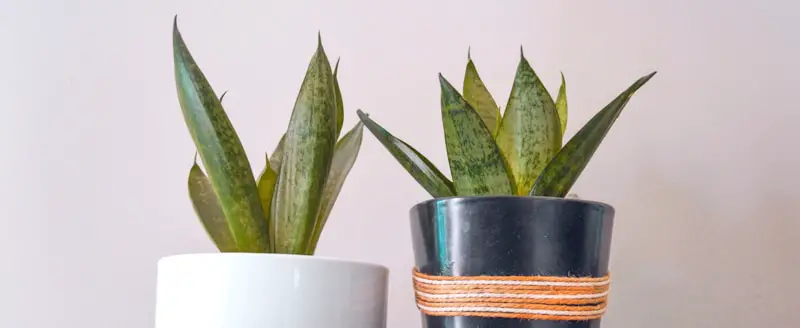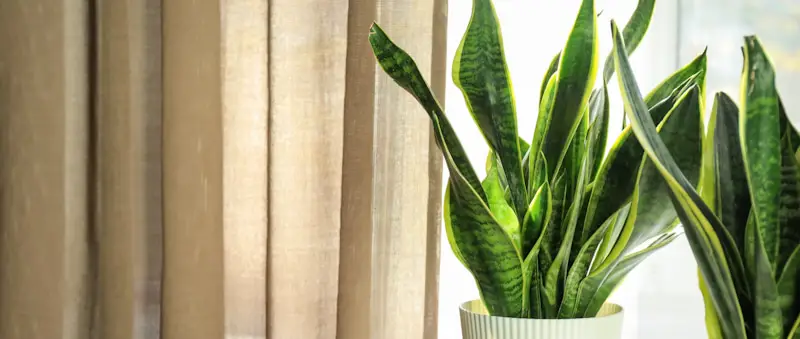The best plant for beginners is the snake plant; they are not only incredibly tolerant plants but may also develop without much upkeep or attention. You might be wondering if you can cultivate a snake plant outdoors based on where you reside. We will help clarify that question in this article.
You can cultivate a snake plant outside. They can be raised either directly in the ground or in pots. However, snake plants need warmer temps to thrive. Therefore, the snake plant might not thrive outside if you reside in a region with an average annual temperature under 55 degrees Fahrenheit.
While growing a snake plant outdoors is feasible, there are a few things to keep in mind to give the plant the best chance of success. Find out what influences a snake plant’s growth if planted outside by reading on.

Snake Plant Outdoors
Many of the most popular indoor plants are snake plants. They are well known for their low maintenance requirements and advantages to our homes. For instance, they assist in removing airborne pollutants like formaldehyde, according to NASA research.
Outside, snake plants can flourish. Most of them will even survive in shaded regions, and they can endure most types of lighting. However, they are sensitive to cold temperatures and prefer warmer environments.
Snake plants have a reputation for being nearly unbreakable. Understanding how little water snake plants need to grow is frequently the toughest challenge. If you want to cultivate a snake plant outside, there are some other things to consider; below are some.
Lighting
Changes in lighting have little to no impact on snake plants. Either dimly lit or heavily lit areas, snake plants will still grow. While you can put them on the terrace or in the garden, they do best in bright, indirect light. It is better to keep them out of strong direct sunlight because prolonged exposure to it can dry them out.
Additionally, you should stay away from dimly lit regions because they might make the plant’s leaves droop and finally drop off. If you want to grow your snake plant outside, choose a spot facing west or south so it may get both indirect and direct light daily.
Repotting
Snake plants are renowned for their slow growth and infrequent requirement for repotting. They might only need to be repotted each five to ten years if you put them in a dimly lit outdoor area. They could necessitate being repotted after two to five years if they are kept in a location with strong lighting.
They adjust well if their roots are allowed to travel freely inside their pots, although they love to be packed. It is quite normal and would not impede the plant’s growth if you discover that the outdoor snake plant has gotten more crowded throughout the year’s cold season.
Water
Snake plants may thrive with little water. The snake plant should be watered as soon as the soil is completely dry. The plant’s overall size and the humidity levels outside will determine this. Between two and six weeks is enough time for snake plants to go without water.
You should place your snake plant in a pot by itself or distant from other plants that need more frequent watering if you are planting it in the ground outdoors.
Outdoor Pests
Largely pest-resistant snake plants are another great advantage, especially when grown outside. However, if the environment is not kept up to some degree, they can develop a pest infestation like any other house plant. Spider mites and mealybugs are the most frequent pest species that harm snake plants.
If you do not get rid of these pests immediately, they can eat the leaves on the snake plant, making it ill and wilted. Rubbing alcohol or neem oil applied to the plant leaves is the most typical removal method.
Temperature
Native to West Africa, these plants are tropical. As a result, they may flourish outdoors in warm climates with temperatures ranging from 55 to 90° Fahrenheit. Due to their extreme sensitivity to cold, they cannot endure temperatures below 50° Fahrenheit for more than a few days.
Soil
Snake plants can be grown outside in normal soil as long as the soil has good drainage. You can use ceramic, porcelain, or terracotta pots when putting your snake plant outside. Ensure the pot has enough drainage holes, however. Additionally, you can use soil created especially for succulents, cactus, or snake plants.
Snake Plant Light Requirements
Snake plants are incredibly versatile, particularly when it pertains to light requirements. These hardy plants can tolerate any amount of light, from low to intense. Brighter light generally promotes faster growth, but intense direct sunlight can burn the foliage, especially if they are outdoors.
When buying snake plants, pay attention to the pot tags. To maintain their brightest leaf color, some types, particularly variegated ones, require a certain amount of light. Snake plants can thrive in dimly lit areas with shade. Unlike other plants, these adaptable plants can endure reduced light levels. However, their growth rate may be slightly slower in these dim environments.
Can Snake Plants Live Outside In Winter
Tropical plants called snake plants are easily harmed by the chilly winters. Snake plants must be kept inside over the winter. They might, however, be able to make it through the winter in the open if properly cared for. Approximately every 10 to 14 days in the winter.
Instead of watering the leaves, water the container’s edges to cover all the roots. Keep the soil moderately damp during the planting season, but avoid the risk of dryness during the winter. Curled leaves are a sign of cold injury. For 1-4 weeks after exposure to severe cold, the snake plant may develop mushy white areas on its leaves.
Even the robust underground rhizomes used by Sansevierias cannot endure conditions below 32 degrees F. In the winter, you should not keep snake plants outdoors, especially not if you live anywhere where the ground freezes over completely. During the summer, the snake plant will thrive on your balcony, but come fall, you should bring it inside.
Row covers may provide adequate insulation for this plant to endure the winter if you grow it in your garden. However, we would not stake our snake plant’s existence on it. Also, avoid fertilizing your snake plant during the winter; it would not utilize any fertilizer you supply if it is not growing.

Can Snake Plants Live Outside In Summer
Snake plants enjoy being outside, but be careful not to overexpose them to the sun. If you do not, the leaves will begin to dry out, and the scene will not be as appealing. Because they cannot tolerate direct sunshine, snake plants, also referred to as viper’s bowstring plants are frequently maintained indoors.
A snake plant may become sunburned if subjected to indirect lighting for a lengthy period. The snake plants, however, are simple to transport outside; they will flourish when exposed to strong indirect light or perhaps some sunlight; before subjecting snake plants to direct sunlight for an extended period, giving them time to adjust slowly is vital.
Use a shade cover if you wish to leave your snake plant outdoors during the summer so it may receive enough sunshine without direct sunlight. Your snake plant will repay you with lush, green leaves and a healthy plant if it gets at least eight hours every day of bright, indirect sunlight.
Final Thoughts
Snake plants can be cultivated outdoors and are among the simplest plants to care for. They are wonderful additions to patios, driveways, and gardens where they can be paired with other plants. When cultivating a snake plant outside, it is crucial to ensure that the temperature is appropriate for the plant.
Victoria is the owner and main author of hobby plants. She loves spending her free time in her garden planting and taking care of her plants. Victoria hopes you enjoy the content here!

![Fiddle Leaf Fig Outdoors - Can They Survive? [ANSWERED] Fiddle Leaf Fig Outdoors - Can They Survive? [ANSWERED]](https://www.hobbyplants.com/wp-content/uploads/2022/07/fiddle-leaf-fig-outdoors-300x158.jpg)


![How To Propagate Snake Plant? [BEGINNER'S GUIDE] How To Propagate Snake Plant? [BEGINNER'S GUIDE]](https://www.hobbyplants.com/wp-content/uploads/2022/08/how-to-propagate-snake-plant-300x158.jpg)
![How to Repot A Snake Plant? [STEP BY STEP GUIDE] How to Repot A Snake Plant? [STEP BY STEP GUIDE]](https://www.hobbyplants.com/wp-content/uploads/2022/08/how-to-repot-snake-plant-300x158.jpg)

![How Often Do You Water A Snake Plant? [FIND OUT HERE] How Often Do You Water A Snake Plant? [FIND OUT HERE]](https://www.hobbyplants.com/wp-content/uploads/2022/07/how-often-do-you-water-a-snake-plant-1-300x158.jpg)
![Mother Of Thousands Plant [Complete Plant Care Guide] Mother Of Thousands Plant [Complete Plant Care Guide]](https://www.hobbyplants.com/wp-content/uploads/2022/07/mother-of-thousands-plant-300x158.jpg)
![How Often Should You Water Pothos? [Complete Care Guide] How Often Should You Water Pothos? [Complete Care Guide]](https://www.hobbyplants.com/wp-content/uploads/2022/07/how-often-to-water-pothos-300x158.jpg)
![Majesty Palm Plant Care: [Complete Beginner's Guide] Majesty Palm Plant Care: [Complete Beginner's Guide]](https://www.hobbyplants.com/wp-content/uploads/2022/08/majesty-palm-care-300x158.jpg)
![Exotic Angel Plant Care: [Complete Beginner's Guide] Exotic Angel Plant Care: [Complete Beginner's Guide]](https://www.hobbyplants.com/wp-content/uploads/2022/08/exotic-angel-plant-care-300x158.jpg)